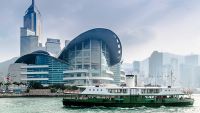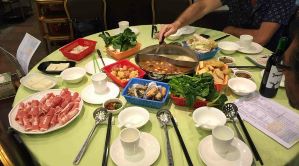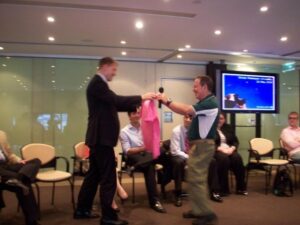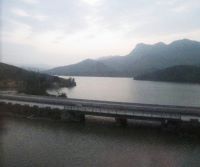As we hurtle from Hong Kong to Beijing (or another 20-plus-hour train ride)
It’s always difficult (for me anyway) to leave Hong Kong, and I think our students on this trip now know why; if you are going to have extra time anywhere, this is the place. We had a lot of time here partly because the train to Beijing doesn’t run every day; and I think it’s a great place to visit because of the comfort level most foreigners have here. Although the city is over 94% Chinese, and today over 80% of the visitors come from the mainland, Hong Kong was British long enough (1841-1997, with the exception of WWII) to have a veneer of Westernization.

Consider the need to get around. The Star Ferry may well be the best bargain in town, if not the world. Connecting Hong Kong Island and some of the over 400 smaller islands together, as well as the Kowloon Peninsula, the Ferry provides some of the most stunning views of the stunning harbor. The rapid transit lines move millions of people a day, and the double-decker busses and trams make sightseeing fun. Jim and I took the Star Ferry across last night to Central (the Financial District), then took the train back to Kowloon to find a place to eat, along the street my friend Eleanor had recommended near our hotel for dumplings.
Food is another reason to visit Hong Kong, as I mentioned before. Before we left today, Eleanor and her sister took me and Jim to the Little Sheep restaurant. That’s the English name. In Chinese, it’s the Little Fat Sheep restaurant. It’s on the 2nd floor (which is really the third floor), and I’ve  found that above the second floor one sees few Guilo (foreigners). That’s not surprising since none of the menus were in English—but with our friends, we had one of the best dim sum meals here (and we’ve had several great dim sum meals). There’s an old saying in this area about Cantonese food, “if it flies and isn’t an airplane, we eat it; if it has four legs and isn’t a table, we eat it.” I would bet a good Cantonese chief could make a table or an airplane taste pretty good.
found that above the second floor one sees few Guilo (foreigners). That’s not surprising since none of the menus were in English—but with our friends, we had one of the best dim sum meals here (and we’ve had several great dim sum meals). There’s an old saying in this area about Cantonese food, “if it flies and isn’t an airplane, we eat it; if it has four legs and isn’t a table, we eat it.” I would bet a good Cantonese chief could make a table or an airplane taste pretty good.
Yesterday’s group visits demonstrated to me what Mark Sheldon, IWU’s ambassador to East Asia, and I discussed: We have wonderful alumni and contacts through our alumni. Mark and Matt Drege, a 1999 alum, talked  about the expatriate life. Both came temporarily—and have stayed, in Mark’s case, almost 30 years, and in Matt’s case, about 6 years. Mark has had a variety of academic roles, mostly in political science, and is familiar with not-for-profits and the politics of the area; Matt came out with PWC, an accounting firm, and did not want to go home.
about the expatriate life. Both came temporarily—and have stayed, in Mark’s case, almost 30 years, and in Matt’s case, about 6 years. Mark has had a variety of academic roles, mostly in political science, and is familiar with not-for-profits and the politics of the area; Matt came out with PWC, an accounting firm, and did not want to go home.
They did an excellent job in describing what it’s like to live in Hong Kong, and to work there. Mark has been active in the democracy movement—and has been in Hong Kong long enough to vote. He said that the presence of so many mainlanders (they can have 7-day visas; ours were for 90 days) sometimes creates tensions because of the cultural differences (Cantonese is the preferred dialect, not the Putonghua of the mainland). Matt changed jobs (and reinvented himself three or four times since leaving IWU; he stressed the importance of continually changing yourself to fit changing times) to work with AIA in corporate governance, and helped the company in its divorce from AIG. It sounds like he has done some interesting work. I met him at Starbucks where he was arranging his day, and his phone call referenced business in Thailand and the Philippines. His investment strategy includes major Asian enterprises, include having some savings in Renminbi.
Queenie Li, who was my advisee and a double major in business and music, helped her parents’ presentation to us on their company. Mr. Li is what Mark described as a typical “Cantonese” entrepreneur, having built a niche textile company—in cashmere—from scratch. The competitive nature of the business led to factories in China and Bangladesh to lower costs. He said that the Bangladeshi workforce can be unpredictable. They like to strike, and one time struck for wages lower than what they were being paid! He contracts with major retailers in the United States and Europe, but also has several stores of his own, and his own brand. He stressed a lot of personal contacts (more important than the digital age), being honest, and understanding the complexities of cultures. He took us to one retail outlet, and several of our students will look a lot better next year (or their parents will).
It was obvious when we crossed the border, especially when we left Shenzhen, the town just north of Hong Kong; it was one of the first cities Deng Xiaoping opened to foreign trade in the early 1980s, and is now a booming city of about 4 million, which resembles Hong Kong a lot more than what we’ve seen since. As we’ve gone deeper into China, we’ve seen new infrastructure, especially roads, but cities that are not neon-dazzling.
One of several reasons for taking the train is to demonstrate to students that Asia is not just glittering cities with skyscrapers, and as we’ve gone through Guangdong province, the manufacturing capital of the world, they’ve certainly seen that.
On to Beijing—just under 20 hours more!
It’s morning now in North China, and some observations on the countryside we’re passing through: We’re in wheat country (the home of Chinese noodles); some of the agricultural implements are mechanical—looks like harvesters to this city boy; the houses are brick, very functional, which is to say, plain; the rust belt is alive and well here; and the infrastructure improvements are real, although in the countryside, much of the traffic is in  trucks. Rural China, as our students will see, is quite different from Beijing. Someone told me that the move from the farm to the city has lessened because the government is now subsidizing farm products (and commodity prices are escalating, leading to inflation here and elsewhere, but to an improved standard of living in the countryside). Farm unrest has toppled many a dynasty, and the current one is well aware of that.
trucks. Rural China, as our students will see, is quite different from Beijing. Someone told me that the move from the farm to the city has lessened because the government is now subsidizing farm products (and commodity prices are escalating, leading to inflation here and elsewhere, but to an improved standard of living in the countryside). Farm unrest has toppled many a dynasty, and the current one is well aware of that.